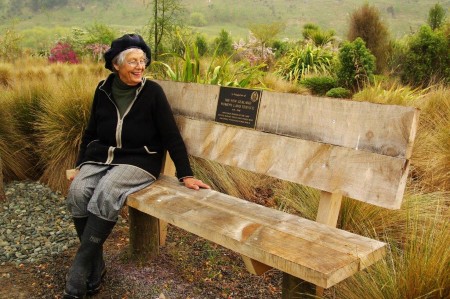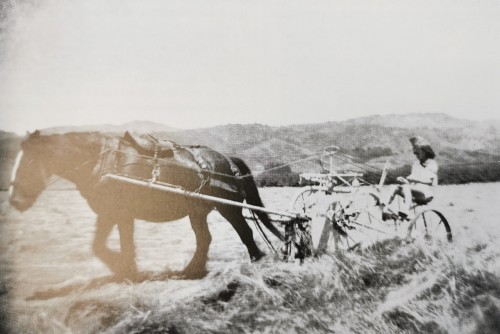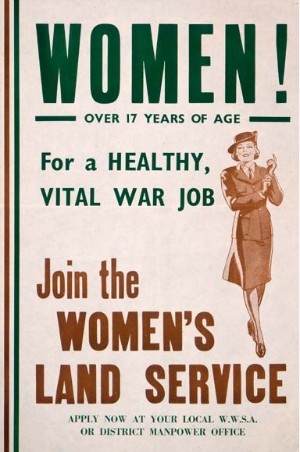Honouring our wartime ‘land girls’
14 October, 2020

Lady Fiona Elworthy checks out the plaque and memorial seat at Rongomaraeroa, which honours the Women’s Land Service. Photo: Roland Dale
by Simon Edwards
The ‘Land Girls’ are largely unsung heroes of New Zealand’s World War II experience and Fiona, Lady Elworthy, of Timaru was determined that in her district at least there should be a memorial to them.
While men took up arms against the Axis enemies, Women’s Land Service (WLS) members placed on farms back home had their own sorts of battles with totally unfamiliar tasks, long hours, isolation, equipment shortages – and with prejudice.
Thanks to the efforts of Lady Elworthy, former Women’s Land Service members Sadie Lietze now 97, and Joan Butland – who forged her father’s signature at age 17 so she could join the WLS – a plaque and seat will be unveiled during a ceremony and picnic at Maungati in South Canterbury on Sunday.
The memorial sits among the cherry trees and native plants of Rongomaraeroa (the Long Pathway to Peace), a reserve established by Lady Elworthy to honour her late husband. Sir Peter Elworthy, a former Federated Farmers president, was a Nuffield Scholar who was also founding president of the NZ Deer Farmers’ Association.
“Peter was greatly encouraging of women taking up any career they wanted; he always chose on merit, not gender,” Lady Elworthy said. “He was ahead of his time in that regard. He’ll be so happy we’re having this (event).”
Dianne Bardsley is guest speaker at Sunday’s celebration. The author of The Land Girls: In a Man’s World, 1939-1946, she records that our early efforts to emulate Britain’s Women’s Land Army of WWI and WWII failed to fire. The Minister of Agriculture was not in favour; neither was the Farmers’ Union (later Federated Farmers), nor its Women’s Division.
Some were sceptical frail ‘town’ girls were capable of the work, others said they’d be more useful as domestic help in the farmhouses than out in the fields and milking sheds, and others couldn’t countenance the idea of females doing ‘men’s work’. There were farmers’ wives who didn’t want “town hussies” tempting the dwindling number of menfolk still on farm.
Typical was the sentiment in a letter from a NZ Farmers’ Union member published in The Women’s Weekly in 1940: “Women who can cut the throats of sheep and carry heavy loads will not make healthy future mothers of the race.”
But in that era, New Zealand was still the UK’s food bowl. We also had to help feed the 100,000 American servicemen and women in the Pacific, and our own people had to eat. Pressure was on to get extra hands on the farms stripped of some 23,000 men for overseas service.
In late 1941 the government set up a Women’s Land Corps, administered by the Women’s War Service Auxiliary and the National Service Department. Recruitment was left to the WWSA and by July 1942 an underwhelming 203 women had been placed on farms.
In September, the Corps was re-organised, with better pay, conditions and a chocolate brown uniform, as the Women’s Land Service. Women working on relative’s farms were eligible.
MPs Mary Grigg (National) and Mary Dreaver (Labour) banged benches in Parliament and set off on a recruitment drive to all corners of the nation.
By the time the WLS was disbanded, of 4,290 applications 2711 land girls had been placed on farms and many hundreds of others unofficially served on family land. More than 400 other applicants were turned down because they were already in essential occupations.
Perhaps inevitably, with men and young land girls living and working from isolated farmhouses, or even unlined corrugated iron whares, babies were born.
But in her interviews with 130 former land girls for her book, Dianne Bardsley also heard many stories of lifelong friendships made, and women’s lives changed forever.
“Several women gave up their university education. Many left careers or did not embark on what they had planned, as five years of land service had changed lives and circumstances. Some were bitten by the land bug and never returned to city life.”

Land girl Kathy Doran turning hay with ‘Madame’ in the Bay of Plenty, January 1941.
One WLS recruit, Ruth Atchison, had this to say about Gwen Robinson, one of two Wanganui girls who came to work on a farm in a remote part of Taranaki: “…Gwen was an only child, and she was the most delightfully novice land girl. She didn’t know a chook from a rooster. She had to be taught all the basics like how to milk a cow, ride a horse and work a dog – and she was great fun.
“When I look back I realise how hard it must have been for her…from the middle of a city to the true backblocks. No electricity, just steep hills and more steep hills. We had two girls who just couldn’t cope – the long days, the isolation and the animals were too much.
“We land girls had to be prepared to do anything,” Ruth said. “To shoot or knife a wild pig or cut a sheep’s throat, as we could easily be five miles or more from the house. The wild pigs would come down and eat lambs, so they had to be dealt with.”
Dianne finds it interesting – and telling – that despite all the servicemen being overseas, and trucks and other equipment commandeered for the war effort leaving many farms to do the bulk of field work with horses, output of all production went up – sheep, dairy, wool, pork, poultry.
The Women’s Land Service was disbanded in April 1946. They were not invited to march in the end-of-war parades with other service organisations and instead of the gratuities that were expected when the fighting was over, the land girls received brief thank-you letters, directing them to return their uniforms and working clothes.
Small badges and a certificate to former land girls were finally given out in 2002. But those land girls who were still alive then were sad that small recognition was never extended to the families of WLS members who had died since the war.
When Dianne travelled the country in the late 1990s to research her book, she found more than a few of the women had carried on working the land in their own right, and were highly successful and well-regarded farmers. That was a source of admiration and some envy from farmers’ wives overseas, her book notes.

As former land girl Dianna Wanklyn told her: “They wished they could be out on the farm making responsible decisions and working beside their husbands as we do. They could hardly understand how I came to hold national office in a stud breeding organisation.”
Lady Elworthy said wider family members of former land girls, especially the next generation, tended to be “so proud of what their mothers, their grandmothers, their aunts had achieved.
“They may not have been out on the tractor again, but they could understand the economics of it, the business side of farming. It strengthened New Zealand agriculture.”
- Blessing of the Women’s Land Service memorial bronze plaque and seat, 11am Sunday 18 October, Rongomaraeroa Peace Walk, 143 Timaunga Road, Maungati District South Canterbury, followed by picnic, wartime songs and displays.